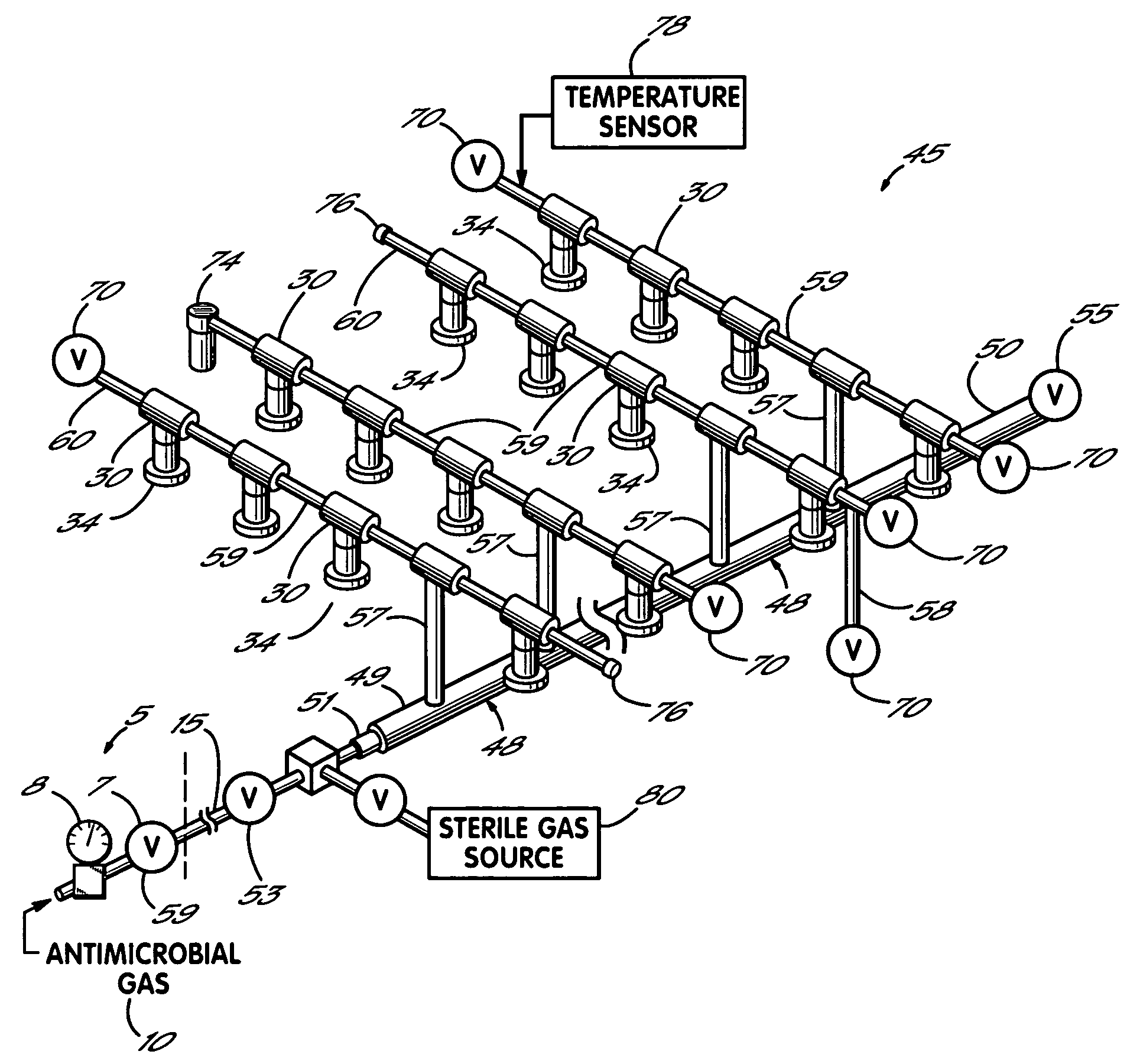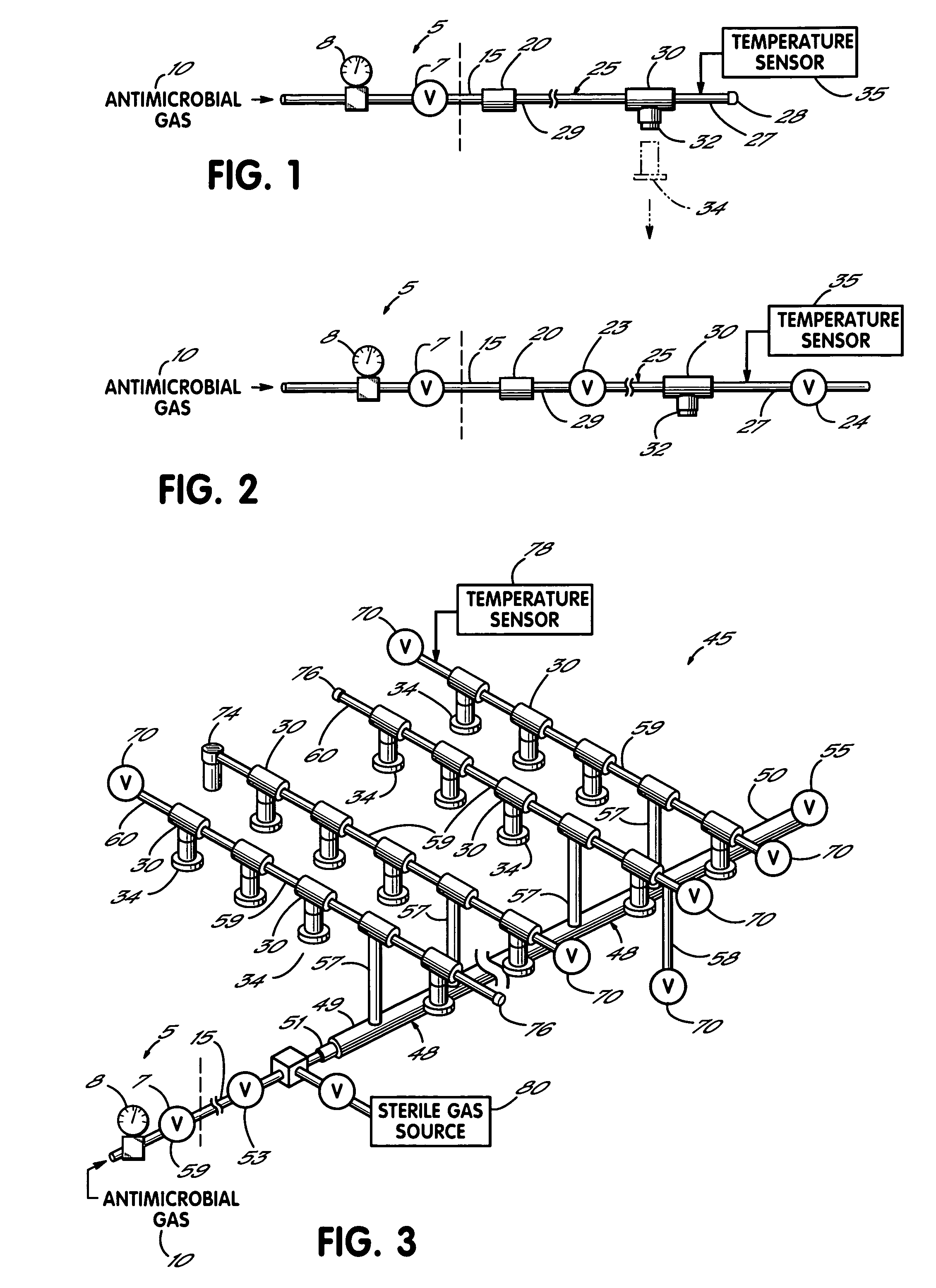Sterilization of fire sprinkler systems
a technology of fire sprinkler system and sterilization, which is applied in the direction of multi-way valves, plug valves, water/sewage treatment by substance addition, etc., can solve the problems of reducing fire protection, requiring higher operating costs, and reducing hydraulic capacity, so as to achieve low cost and simple
- Summary
- Abstract
- Description
- Claims
- Application Information
AI Technical Summary
Benefits of technology
Problems solved by technology
Method used
Image
Examples
example 1
[0064]A 1-inch diameter microbiologically contaminated fire sprinkler pipe having one sprinkler head was obtained from a known contaminated system. The end of the pipe was capped, the sprinkler head was removed and plugged, the pipe was then filled with microbiologically contaminated source water and the other end capped.
[0065]A stream sterilization test of the pipe was conducted as shown in FIG. 1. One end cap of the pipe was removed and the contaminated water poured out of the pipe and a pre-sterilization sample of the water and scrapings from the interior pipe wall were taken under sterile conditions for microbiological testing employing a MICkit™ supplied by Bioindustrial Technologies, Inc., Georgetown, Tex. The microbiological samples were incubated for three weeks at 35° C. and observed for microbiological growth.
[0066]After pre-sterilization sampling, the pipe was connected to an adapter attached to the steam source (a 10-horsepower, 400,000 BTU Boiler) having a shut-off ball...
example 2
[0073]The steam sterilization pipe test was further modified for the following examples, as shown in FIG. 2, in order to achieve the higher sterilization temperatures. Two ball valves were attached to each end of the fire sprinkler pipe being tested in order to control the inlet steam pressure and flow, the outlet steam pressure flow, and to drain condensate from the test pipe.
[0074]Microbiologically contaminated water was obtained from a “dead end” water feed-line to a fire protection system and was assayed microbiologically using the MICkit™ giving the following results after only 2 days of incubation at 35° C.:
[0075]
LNBIRBAPBSRBAPC*PositiveNegativePositivePositive>1000*APC = Aerobic plate count of the number of colony forming units per mil. of water
No further change in the results were noted after 15 days of incubation.
[0076]A new 1-inch diameter pipe section with fittings, as shown in FIG. 2, was filled with the microbiologically contaminated water and stored at ambient temperat...
example 3
[0080]The sterilized pipe from Example 2 was then filled with potable tap water containing 50 ppm sodium hypochlorite and allowed to stand at ambient temperature. The sodium hypochlorite, being an oxidizing agent, rapidly dissipated when in contact with the interior iron pipe surface. Analysis of the water after 24 hours showed 0 ppm sodium hypochlorite.
[0081]The water was left in the sterilized pipe for an additional seven days and was then sampled and assayed for microorganisms. The microbiological results were all negative for LNB, IRB, APB, SRB and <1 for APC.
[0082]This demonstrates that a sterilized fire protection system when filled with sterile water will remain sterile. Other biocides or methods of sterilization of the feed water, i.e., ultraviolet radiation, distillation, micro filtration, etc., may be used to prepare the sterile water to charge the sterile fire sprinkler system.
PUM
| Property | Measurement | Unit |
|---|---|---|
| temperature | aaaaa | aaaaa |
| length | aaaaa | aaaaa |
| temperatures | aaaaa | aaaaa |
Abstract
Description
Claims
Application Information
 Login to View More
Login to View More - R&D
- Intellectual Property
- Life Sciences
- Materials
- Tech Scout
- Unparalleled Data Quality
- Higher Quality Content
- 60% Fewer Hallucinations
Browse by: Latest US Patents, China's latest patents, Technical Efficacy Thesaurus, Application Domain, Technology Topic, Popular Technical Reports.
© 2025 PatSnap. All rights reserved.Legal|Privacy policy|Modern Slavery Act Transparency Statement|Sitemap|About US| Contact US: help@patsnap.com


